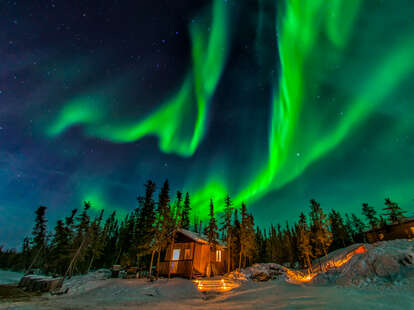See the Northern Lights the Way a ‘Star Wars’ Icon Did
May the aurora borealis be with you.
The sun was just setting at 11:30 pm on a snowy evening in late April, 2013 when Star Wars actor Carrie Fisher found herself pacing on a frozen lake, waiting for something special to happen. She did this for over two hours in -9 degrees.
“But fuck it,” she wrote in a Port Magazine article, “there we all were, waiting for the stars to shut their shiny eyes so we might better see a swirling streak of icy smoke, spiralling up from some unseen fire glowing there beneath the horizon.”
When Fisher decided she wanted to see the northern lights before she passed away in 2016, by god was she going to do it, temperatures be damned. She had previously tried to witness the magic of the aurora borealis in Sweden, Scotland, and Iceland and had so far been unsuccessful.
This time, she came to Canada.

Specifically, Fisher went to a little city called Yellowknife, the only city in the Northwest Territories, where the local university is called Aurora College. And when she decided to risk another—and last—shot to see silently roaring green and purple lights dancing across a huge, dark sky, the late and once-upon-a-time Princess Leia chose to go with indigenous-owned North Star Adventures.
“If the skies are clear, you have a 95% chance of seeing them in Yellowknife,” says Joe Bailey, founder of North Star Adventures, the first known aurora chasers. Yellowknife has been nicknamed “The Aurora Capital of North America.” And since 80-90% of the aurora oval is in Canada, plus its low humidity and light pollution, it makes sense why the chances to spot the celestial phenomena is higher here than anywhere else in the world.

But there’s another reason why someone like Fisher would choose North Star Adventures, who claim to be the best and first ever aurora hunters.
With a mischievous smile, Bailey says their tour guides have 50,000 years of experience. That’s because the company is 100% indigenously owned. He adds, "We are North America's original tour guides." And though he jokes about how that turned out for his people in the history books, he says with utter sincerity that his people are just as welcoming today to any visitor.
"Storytelling: that's what a true education is."
The tribal citizens of the Dene Nation have always been surrounded by the northern lights and know them well. "I’ve been with the aurora since I was a baby," says Bailey, but he knows that his aurora-chasing tradition extends for generations beyond just his own life. Passing down knowledge from elders is a crucial part of indigenous culture. It’s something Bailey picked up from his own elders out in the tundra, where, as he assures us, “You can live in a canvas tent at -40 degrees.” And that’s exactly what Bailey did as a child with his grandparents.

Before you start to panic, guests who travel with North Star Adventures in the winter can opt for much more than just a canvas tent. The package includes a stay at a hotel or bed and breakfast, transportation, Canada-level winter clothes, professional photos and videos, and hot chocolate with maple cookies, lest you forget what country you’re in. You can even opt to add food, additional tours, and dog sledding.
While many (including yours truly) hear Canada and think “cold”—never mind words like “Arctic Circle,” “Yukon,” and “tundra”—there are ways to deal with the weather and an incredible reason to do so. Give me a wood-burning fire in a cozy cabin, hand warmers, and stiff drinks before and after, for the chance in a lifetime? Now we’re talking.

North Star Adventures takes care of everything for guests, plus all the passed-down knowledge and a human connection that’s impossible to quantify—because another thing that comes for free in the package is stories, and lots of them. “Storytelling,” says Bailey, “that's what a true education is.”
As a citizen of the Dene Nation, Bailey explains that the northern lights are what his indigenous ancestors say are the souls of people who've passed away. According to the Dene Nation, when you see the lights overhead moving so fast, that means the souls in the sky are trying to tell us that we no longer need to be sad anymore. They’re a reminder to keep living.
It's something that resonates with many who see them.
"It wasn’t every day I got to see her in such awe of something."
"I can hear people crying, overcome with emotions," Bailey says. He believes the power of the aurora borealis is the reason why, in another example, an 82-year-old Australian woman would stand for three hours in the cold, with a warm thermos drink and a hell of a good parka.

We may never know if Carrie Fisher saw souls in the sky telling her to be at peace, or what she felt when she saw the northern lights rippling—which she did finally see on this trip. Her assistant at the time described “standing on a frozen lake, watching her look up and marvel,” to The New York Post. “She’d done and seen so many amazing things in her life by that point, it wasn’t every day I got to see her in such awe of something.”
Or we might refer to her own words of “savouring each sip our thirsty eyes might swallow.”
The only real way to know what it feels like is to see it for yourself. If you do go, pack your warmest clothes, a determination to embrace the elements, a tip for your indigenous tour guide, and Fisher’s last wish: “I hope auroras run through your veins until you feel you belong, find your place so close to right that it manages to overlook wrong.”
